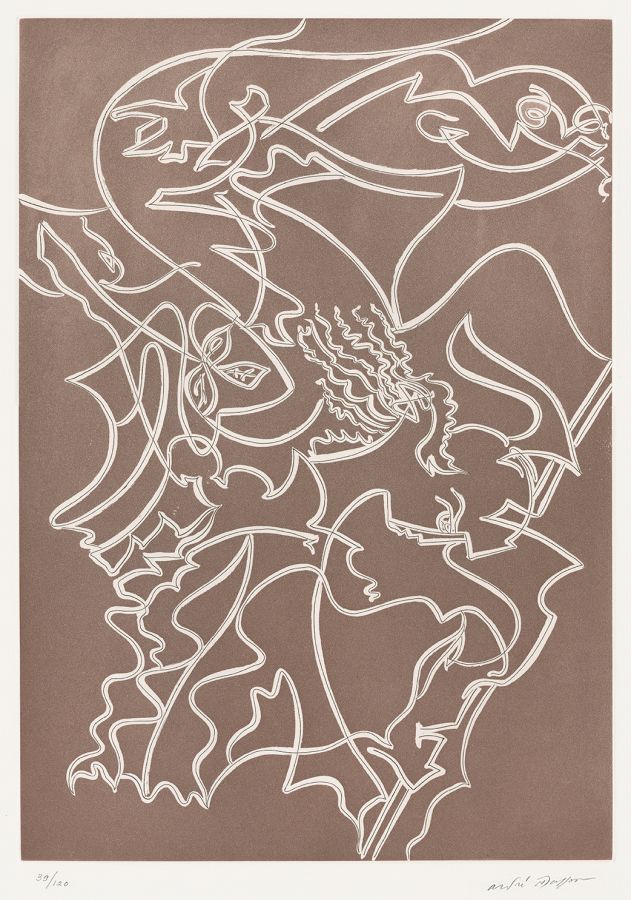Athena is an etching and color aquatint by André Masson from the portfolio L’Odyssée published in 1978. Athena is plate I of twelve plates that comprised the portfolio which was published by UNESCO World Heritage for the project to save the Acropolis. Athena is pencil signed and editioned 39/120 and was printed at Atelier Crommelnyck on ivory Rives velin wove paper. The platemark measures 19-1/2 x 13-11/16 inches.
In mythology, Athena, the patroness of the city of Athens, is the goddess associated with wisdom and war. She was also masterful in weaving and stitchery, and inventive and some associate Athena with the invention of the war chariot and the warship. With her art of wisdom, Athena guided Odysseus during his decade long journey back to Ithaca after the Trojan War but she also bestowed wise counsel to Heracles, Jason and Perseus.
Athena is often depicted as the goddess of war and that is how Masson presents her. She is dressed in a citron which is fastened at her shoulder, wears a Corinthian helmet, and holds a long spear in one hand and a shield in the other. The gestural lines in the upper left could represent a flying owl which is often depicted with Athena.
André Masson, painter, sculptor, illustrator, designer, and writer, was born 4 January 1896 in Balagny-sur-Thérain in northern France. He spent most of his youth in Belgium and, at eleven years old, he enrolled in the Académie royale des beaux-arts and the École des arts décoratifs in Brussels. At age sixteen, Masson was awarded the Grand Prix de l'Académie for painting.
Masson moved to Paris in 1912 to study at the École nationale supérieure des beaux-arts. While in Paris, he became interested in mythological-themed paintings of Nicolas Poussin, subjects that he would later treat in his own work. In 1915 he joined the French infantry and fought in the battles of the Somme. He was seriously wounded during a battle in 1917 and spent months in the hospital recovering physically and psychologically. The war influenced Masson’s art and he later wrote, “The field of battle made a human being of me. It literally threw me into the humus humain.”
In 1919, he moved to the south of France for a few years before returning to Paris. There he participated in the Surrealist movement between 1924 and 1929 and became a leading practitioner of automatism. Under the German occupation of France during World War II, Masson’s work was declared degenerate. He fled France eventually taking refuge in United States, first living in New York before moving to rural Connecticut in 1941. It was during this time that he worked at Stanley William Hayter’s experimental workshop Atelier 17 at the New School in New York.
Masson returned to France in 1945 and settled in Aix-en-Provence in 1947. He was awarded the Grand Prix National des Art in 1954 and, in 1958, the Venice Biennale dedicated an entire room to his work. As early as 1933 he produced designs for the stage and, in 1965, he was invited to paint the ceiling of the Théâtre de l'Odéon in Paris.
André Masson’s work is represented in collections worldwide, including the Brooklyn Museum, New York; the Art Institute of Chicago, Illinois; the Cleveland Museum of Art, Ohio; the Dallas Museum of Art, Texas; the National Galleries of Scotland, Edinburgh; the Tate, London; the Guggenheim and the Museum of Modern Art, New York; the National Galleries of Scotland, the Ashmoleam Museum, Oxford, U.K.; the Philadelphia Museum of Art, Pennsylvania; the Albertina, Vienna; and the Hirshhorn Museum and Sculpture Garden, Washington, D.C.
Masson died on 28 October 28 1987 in Aix-en-Provence, France.



